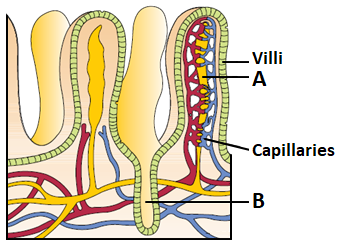Consider the following statements:
I. The common bile duct is guarded by the sphincter of Oddi.
II. Lower esophageal sphincter is also called as the cardiac sphincter.
III. The external anal sphincter is under our voluntary control.
Which of the above statements are true?
1. I and II only 2. I and III only
3. II and III only 4. I, II, and III
I. The common bile duct is guarded by the sphincter of Oddi.
II. Lower esophageal sphincter is also called as the cardiac sphincter.
III. The external anal sphincter is under our voluntary control.
Which of the above statements are true?
1. I and II only 2. I and III only
3. II and III only 4. I, II, and III
The primary dentition in humans differs from permanent dentition in not having one of the following type of teeth
1. Canine
2. Premolars
3. Molars
4. Incisors
Gastric juice of infants contains?
1. maltase, pepsinogen, rennin
2. nuclease, pepsinogen, lipase
3. pepsinogen, lipase, rennin
4. amylase, rennin, pepsinogen
Select the correct match of the digested products in humans given in column I with their absorption site and mechanism in column II.
| Column I | Column II | |
| 1. | Glycines and Glucose | Small intestine and active absorption |
| 2. | Fructose and Na+ | Small intestine and passive absorption |
| 3. | Glycerol and Fatty acids | Duodenum and move as chylomicrons |
| 4. | Cholesterol and Maltose | Large intestine and active absorption |
Cattle fed with spoilt hay of sweet clover which contains dicumarol
1. are healthier due to a good diet
2. catch infections easily
3. may suffer vitamin K deficiency and prolonged bleeding
4. may suffer from beri beri due to deficiency of B vitamins
Sphincter of Oddi will guard the opening of:
1. A
2. B
3. C
4. D
The intrinsic nervous system that is responsible for peristalisis is present in which part shown in the given transverse section of the human gut?
1. A
2. B
3. C
4. D
Study the given diagram and choose the correct statements:
I. A is involved in the absorption of fatty acids
II. B is a gland
1. Only I
2. Only II
3. Both I and II
4. Neither I nor II
In the given diagram showing anatomical regions of the human stomach, A, B and C respectively represent:
- Fundus, Cardia and Pylorus
- Cardia, Pylorus and Fundus
- Fundus, Pylorus and Cardia
- Pylorus, Cardia and Fundus
Assertion: In animals, chemical digestion is necessary.
Reason: Mechanical digestion, typically, precedes chemical digestion, increasing the surface area for chemical digestion.
1. Both assertion and reason are true and the reason is the correct explanation of the assertion.
2. Both assertion and reason are true but the reason is not the correct explanation of the assertion.
3. Assertion is true but reason is false.
4. Both assertion and reason are false.
- If both the assertion and the reason are true and the reason is a correct explanation of the assertion
- If both the assertion and reason are true but the reason is not a correct explanation of the assertion
- If the assertion is true but the reason is false
- If both the assertion and reason are false










